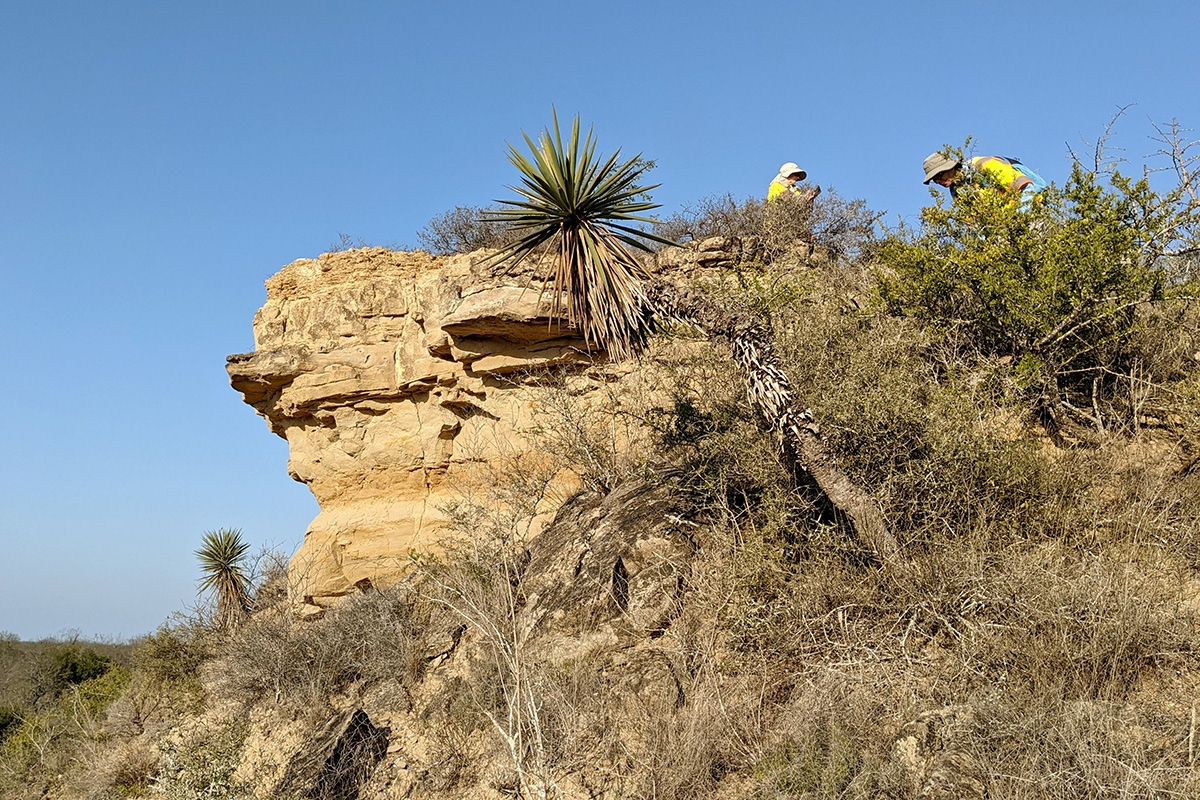
The team searches atop a bluff not far from the Rio Grande.
Photo by Sara Johnson
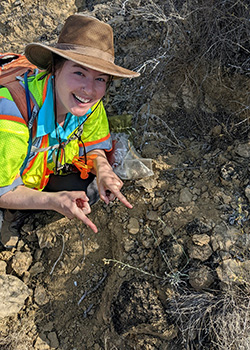
The author hovers near a Zapata bladderpod specimen.
Photo courtesy Sara Johnson
ZAPATA COUNTY, Texas – Our truck rumbles down a dirt road, kicking stones and swirling clouds of dust in our wake. Illinois Natural History Survey senior plant ecologist Brenda Molano-Flores, INHS researcher Janice Coons and I drive at a snail's pace to avoid deep gullies created by flash flooding, a defining feature of this region's bluffs and valleys. The carved sandstone and flow of silt downhill exposes crumbling rock and fossilized oyster beds, a snapshot into the primeval ocean that was once underfoot. We finally reach the end of the road, halted by a locked iron gate. We look at each other and sigh. "Guess we're walking from here," I say.
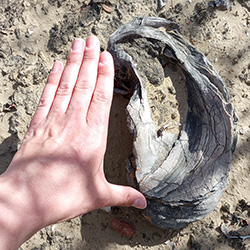
Large fossilized oysters are visible in the bedrock of the Rio Grande bluffs.
Photo by Sara Johnson
The moment our truck door opens, a wall of dense heat hits us and a swift breeze knocks the hat off my head. Looking over the gate, I see that the landscape cuts deeply into a wash that – if we follow it – should lead us to an old service road where we hope to find what we are looking for: the federally endangered Zapata bladderpod, Physaria thamnophila. This rare endemic plant, a member of the mustard family, is named for the region and is found in only two counties in the United States.
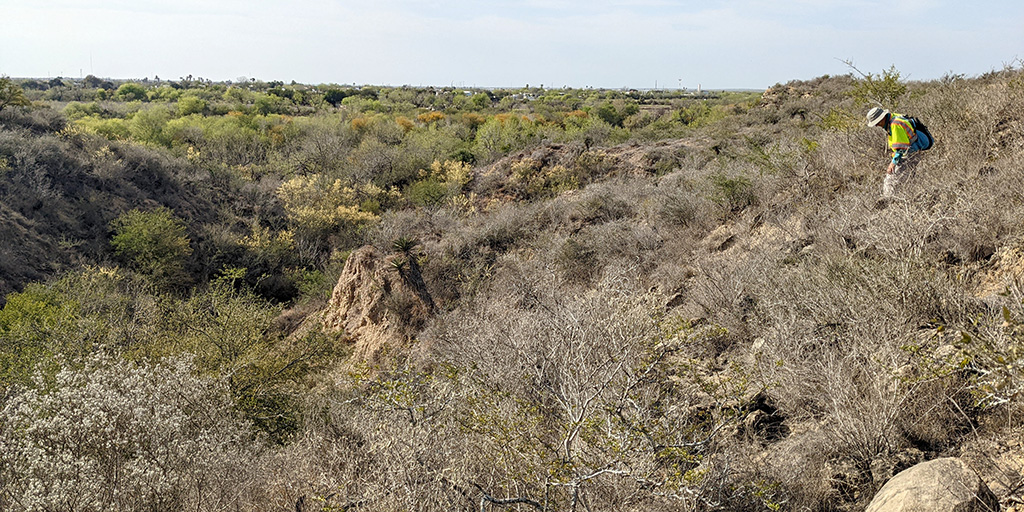
A view of the thornscrub habitat along the bluffs of the Rio Grande.
Photo by Sara Johnson
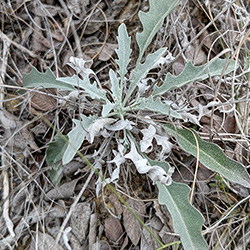
The basal rosette of Zapata bladderpod with remnant stalks from a previous year's blooms. Notice how well the plant is camouflaged against its background.
Photo by Sara Johnson
Deep South Texas is unique. It feels vast and nomadic, sprawling in all directions with hundreds of thousands of acres of ranchland and – if you don't count the cows or the main thruways along the Rio Grande – sparsely populated. It's a diverse region, thanks to the confluence of semi-arid and subtropical climates that meet in central South Texas to form a mixture of grasslands and extremely dry uplands.
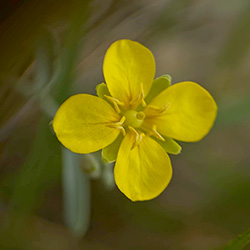
A closeup view of the parts of a Zapata bladderpod flower.
Photo by Sara Johnson
The Zapata bladderpod is aptly named. It inhabits the Tamaulipan thornscrub, also known as mezquital, a dry ecoregion defined by shrubs and desertlike conditions, with seasonal marshlands and intermittent streams. As we search the dense thickets of shrubs and enormous prickly pear, Opuntia lindheimeri, I begin to think these plants don't want to be found.
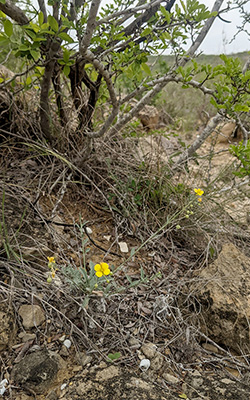
A small flowering Zapata bladderpod near shrubs along a banked road on private lands.
Photo by Sara Johnson
We are here for about three weeks, watching the landscape come alive as a result of a recent rain. Cycles of wet and dry determine the phenology, or life cycle, of many plants. In extreme years, plants hedge their bets and lay low until conditions meet their standards. The huisatche, Acacia farnesiana, pushes forth rich green leaves and yellow fuzz-ball flowers. The Texas ranger's (Leucophyllym frutescens) dusty silver backdrop of leaves begins to produce bright purple blooms, attracting pollinators from miles in all directions.
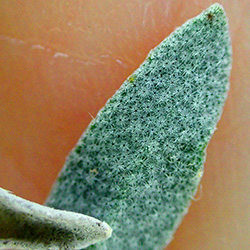
A closeup view of the forked hairs on the back of a Zapata bladderpod leaf.
Photo by Anna Strong
The question is, did this region get enough rain to bring the Zapata bladderpod to life? On previous visits, we saw only crunchy and curled, but alive, rosettes and leaves, with deep taproots anchoring down to water resources below. The key to distinguishing the Zapata bladderpod from other closely related plants is the bifurcate trichomes, or forked hairs, you can find on the undersides of its leaves, only visible with a hand lens or microscope.
We trek the old service road along a flat ridge, which offers wide vistas of the Rio Grande below and rolling hills pock-marked with Spanish daggers, Yucca treculeana, and border patrol towers. We walk slowly, checking bald areas of the ground and at the edges of shrub islands, areas where Zapata's bladderpod can benefit from the dripline of nearby shrubs, which offer a shady and slightly cooler microclimate.
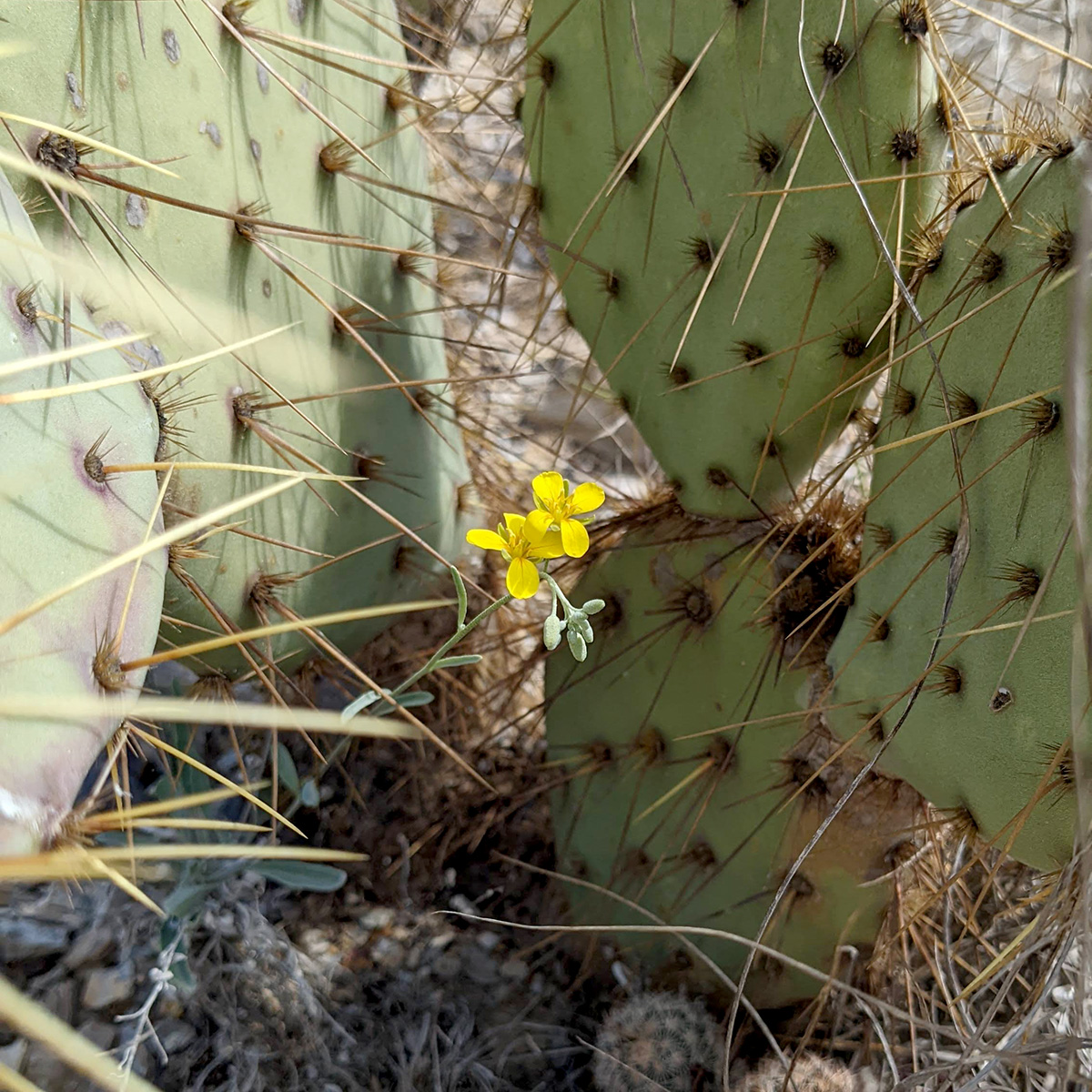
A flowering Zapata bladderpod nestles safely between the pads of a Texas prickly pear cactus, Opuntia linheimeri.
Photo by Sara Johnson
As any field botanist will tell you, you develop a search image for your target plant that stays with you – even when you're not searching. During the field season, even in my dreams, I am continuously scanning and searching the ground.
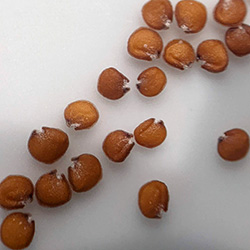
Mature seeds of Zapata bladderpod.
Photo by Sara Johnson
We keep walking in the beating sun and, out of the corner of my eye, I spot a yellow beacon in a shady corner, a bladderpod bloom! It is so much smaller than I expected: a delicate four-petaled pop of yellow atop a long and spindly stalk. It swirls so wildly in the breeze, it's a miracle a pollinator could land there at all. We get to our hands and knees – watching for the thorns! – to get a closer look at this tiny wonder to observe the flowers and pollinators. So few bladderpods flower, this might be a challenging field season.
Each time we visit this area, we don't know what we'll find. The Zapata bladderpod population may persist, or we may find it has mostly disappeared as a result of mowing, grazing, climate change or for some unknown reason. We do our best to count all the individuals at each location to estimate current populations throughout the species range. We also estimate reproductive output, as determined by the number of vegetative and flowering individuals – including remnant flower stalks from previous years.
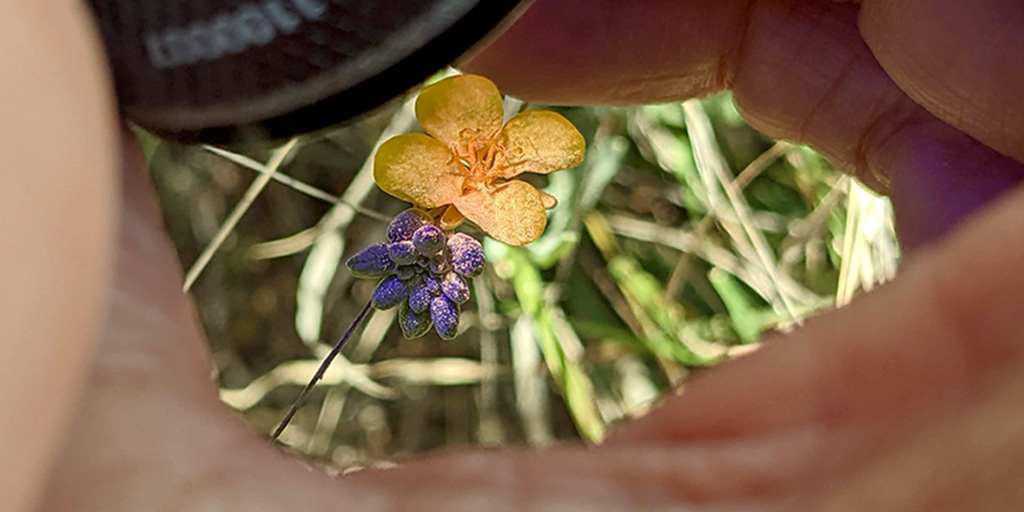
We use fluorescent dye powder to track pollinator movement and pollen dispersal.
Photo by Sara Johnson
We place fine mesh bags over unopened flowers to test the fruit and seed set among open-pollinated and restricted flowers. In future visits, we hope there will be seeds to collect, which we will use in germination trials to determine seed viability and help us understand potential limits to reproduction. Field cameras allow us to capture pollinator visits. Every bit of information is interesting when so little is known about this rare species. Each visit helps us learn a little bit more about this cryptic plant's life cycle, insights that may aid in understanding the species' decline in the wild, which is critical to conservation and recovery efforts in the future.
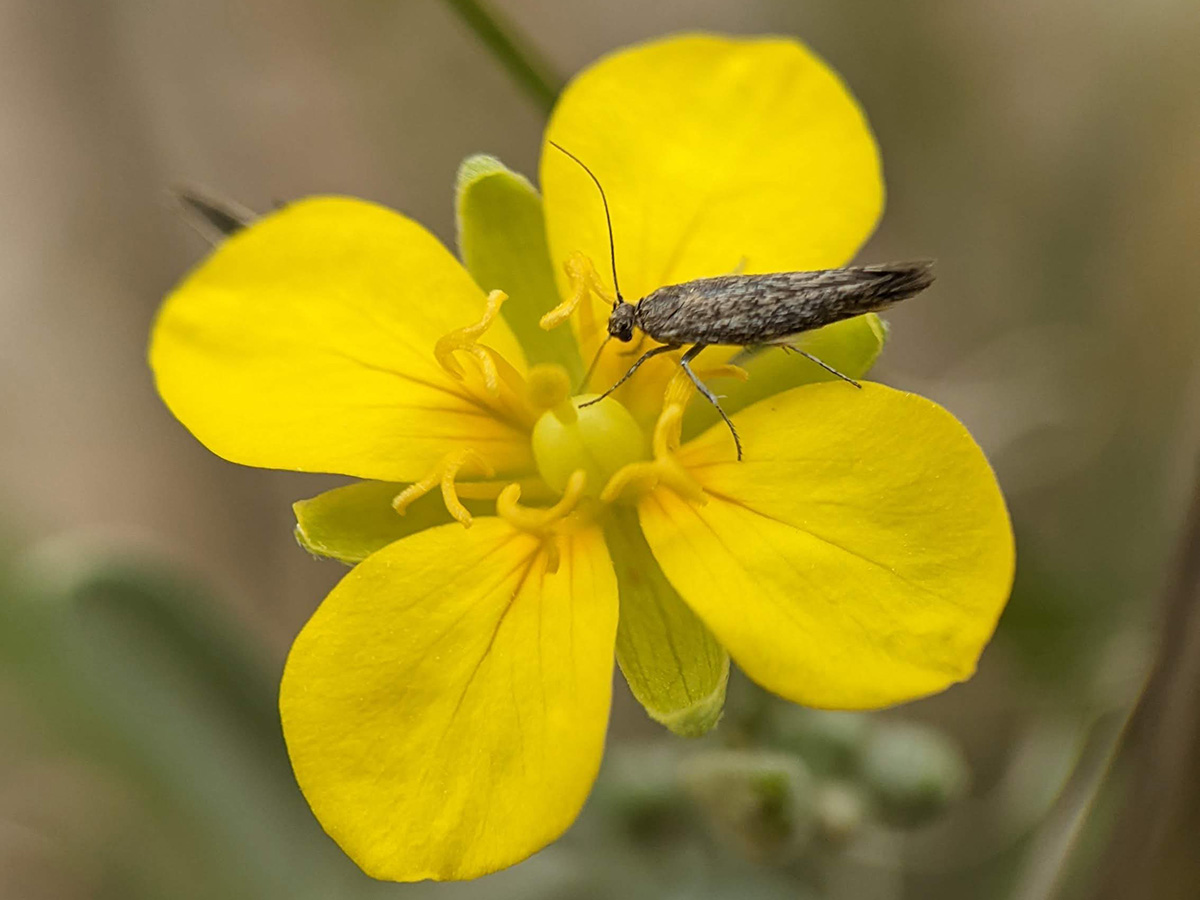
A tiny moth visits a flowering Zapata bladderpod.
Photo by Sara Johnson
As it stands with most rare species, this work isn't always easy, but it is fulfilling. The excitement of seeing one rare plant – let alone a thriving population – is enough to sustain me in this work. Knowing there are so many more species out there to be saved and more breathtaking landscapes to consume are the silver linings to the often-heartbreaking career path of conservation.
We continue our walk along the dusty path and take one last look around at the landscape. The sun is directly above us now, threatening more heat to come. We look at each other with a nod and head on to the next site, with high hopes for better luck – and more rain – next time.






